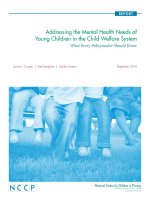Just as i am mental health workbook fall 2020
Bạn đang xem bản rút gọn của tài liệu. Xem và tải ngay bản đầy đủ của tài liệu tại đây (717.93 KB, 50 trang )
Just as I am
The practice of self-compassion and care
A guided journal to free yourself
from self-criticism and feelings of low self-worth
Developed by:
Julia Armstrong, MSW, RSW
Queen’s University,
Kingston, Ontario
This program is based on clinical and personal experience as well as empirically supported
interventions to help you relate to yourself with more flexibility and kindness.
While this resource was created with Queen’s students in mind, I am hopeful that it is
shared with anyone who may benefit.
Finding support
While this resource is designed to help alleviate inner struggles that can cause
low mood and anxiety, it is not intended to replace mental health treatment.
If you are in acute distress or concerned you may be struggling with
significant difficulties, find someone to talk to.
Some things to watch out for:
• Problems sleeping
• Appetite changes
• Prolonged low mood
• Using restrictive dieting, vomiting, or excessive exercise to cope
• Problems arising from alcohol consumption, drug use, or screen time
• Desiring or attempting to harm yourself
• Significant relational conflict or social isolation
You are the best person to decide when it is time to reach out, but others may
be the first to notice and express concern. Hear them out.
If you are nervous about talking to someone:
• You are never alone in your suffering. There is a good chance that many
of your peers are struggling too.
• Many students feel nervous about seeing a counsellor for the first time
but are generally glad they went.
• You may either come alone or bring a friend to any counselling
appointment.
• You decide what to share and what to leave out.
• Unless there are imminent safety concerns, everything you say is
confidential. As counsellors, we take this very seriously. Whenever
possible, we will work with you if we have to consult with others
regarding your safety.
If you are looking for more help, you will find a list of resources – both local
and web-based – at queensu.ca/student wellness.
Journal contents
Welcome……..…………………………………………………………..…………….…1
Making this journal work for you…………………………………..…………..3
Seeing the goodness: Self-assessment……………….…………….…………5
Unconditional human worth……………………………….…………….….……9
Section I: Body Work……………………………………………………….……...14
Section II: Mind Work…………………………………………………….……. ... 25
Section III: Spirit Work………………………………………………….......…....30
Practice Log……………………………………………………………….………. ..... 43
Resources for self-care………………………………………………….……..….44
Finding support in Kingston……………………………………..........….…. . 46
Welcome
It is pretty easy to feel at peace with ourselves when we are validated by a
peer or professor or when we get the mark we were hoping for. But, what
happens if we don’t meet our own or others’ expectations? Or, what if
something devastating and unexpected happens? Often, these unpredictable
circumstances really throw us; we may begin questioning our self-worth and
doubting our abilities. The harsh inner critic just won’t shut up. Fear and
shame can take up lots of space in our world, clouding our perception of
ourselves and others. We end up sabotaging our efforts to do better, and the
cycle continues.
Struggle and suffering are inevitable, especially if we wait for external
circumstances to tell us that we are ok. This is because disappointments,
mistakes, and unexpected circumstances are a central part of the human
experience. We cannot avoid them.
The key to stepping off of the roller coaster is recognizing that we have
infinite self-worth just because we exist. No bad mark, past mistake, or put-
down can change that. We may know, at the intellectual level, that we are
worthy of love and acceptance. Why, then, is it so hard to feel this love for
ourselves? Why are we constantly looking to others for validation and
reassurance? Why are we able to be kind to our friends when they mess up
but cannot do the same for ourselves? It is almost as if our head and heart are
living in completely different worlds. A gap exists between what we think and
what we feel.
1
This journal is intended to help bridge the gap between what you know in
your mind and what you feel in your heart so that you can begin to tap into the
essence of who you are. This essence, your true worth, cannot be shaken by
the circumstances in your life.
More specifically, reading and using this journal can help you:
• face your current difficulties head on using mindful awareness
• soothe yourself when you need it most, and
• navigate the difficulties you face with more courage, confidence, and
inner peace
Expect to feel some discomfort when exploring these pages. It is normal to
want to avoid facing our inner world. The urges often come in the form of
anxiety, frustration, sadness, boredom, fatigue or restlessness. Recognize
when you feel the urge to quit, then do what feels right to soothe yourself.
This could include putting the book down for a while, taking lots of breaks, or
talking about the process with someone you trust. When you offer yourself
what you need in the moment, you are practicing self-care and compassion,
which happens to be the purpose of this journal.
2
Making this journal work for you
Some thoughts on how to make this journal worthwhile for you:
• You might find it helpful to explore the practices with the support of a
friend, mentor, or counsellor. Or, you may prefer to engage with the
material in solitude. Whatever you choose to do is just fine.
• You may want to begin with the section that feels easiest for you.
• If you find that a chapter or practice doesn’t speak to your experience, just
skip it. Yep. That’s right. No required reading here.
• It may be helpful to break grammar and spelling rules when writing to
allow thoughts to flow more freely.
• It’s important to read the sections and actually try the practices that
resonate with you. Practice is the only way to change the relationship you
have with yourself.
• Try a practice a few times when you are feeling relatively calm. Then, when
you are more familiar with the practice, you can use it during more difficult
times.
3
• It may feel like a practice is not working if you don’t notice changes in your
thoughts or feelings right away. Having doubts is normal and ok, but try
not to let them inhibit your progress. Change that matters takes time, so
you can expect some movement that is “two steps forward, one step back.”
• Try a practice wholeheartedly at least three times before deciding whether
it’s worth continuing in your daily life.
• If you would like to deepen your self-care practice, see page 44 for some
recommended readings, online resources, and smartphone apps.
Remember: The goal of these practices is to cultivate compassion for yourself
in whatever state you currently occupy. No one else is going to be evaluating
this writing, so you don’t have to either.
You are worthy of the same love, compassion, and kindness that you give to
others. Try not to get in your own way.
Most importantly, have fun! Try bringing some playfulness and enthusiasm to
the practices.
4
Practice 1: Seeing the goodness
If a person were to see you as you really are, what would he or she most
appreciate or enjoy about you?
As a start, here are some qualities that may ring true to you:
Enthusiastic, spirited Intuitive Expressive
Amusing Disciplined Persistent
Gentle Sensitive Industrious
Loyal, committed Encouraging of others Organized
Determined Well-groomed Physically fit
Logical Open-minded Appreciative
Now, choose one quality that resonates with you. How did you come to
embody that quality?
In the space below, tell a story that goes along with the quality or the
process that you have gone through to embody it.
5
Choose another quality that you can see in yourself:
Enthusiastic, spirited Intuitive Expressive
Amusing Disciplined Persistent
Gentle Sensitive Industrious
Loyal, committed Encouraging of others Organized
Determined Well-groomed Physically fit
Logical Open-minded Appreciative
Can you think of any other qualities that you have? List them here:
Choose one, and tell the story of how you came to embody that quality.
6
Practice 2: Core worth vs. outer layers
Adapted from Schiraldi, G. (2001).
Take a moment to reflect on how you feel about yourself right now. Are you
full of self-doubt, regret, pride, or satisfaction? Or, is there another way to
describe where you are? Try to express in words how you are feeling without
exaggerating or minimizing your current reality:
How I feel about myself today:
What has been influencing these feelings lately? Circle all that apply:
Physical strength My marks today Selfishness
Intelligence Being right Selflessness
Academic achievements Daily self-evaluation My feelings
Friendliness Productivity Capability
Creative ability Confidence Who likes me
Past mistakes My weight How others treat me
My thoughts Social media ‘likes’ Lack of experience
What my parents say What I’m wearing My behaviour
The list you just read through is made up of outer layers. These are
circumstances, events, and performance that are separate from your core self.
It has become normal to confuse the external circumstances of our lives with
our identity and worth, even though the core of who we are is unchanged by
these outer layers.
7
8
I am enough: Unconditional human worth
As you consider the list of outer layers in the previous journal entry, are there any
that you question? For example, it may be easier for you to see that “My weight” is
an outer layer but harder to see “Selflessness” in the same way. Or, you may view
“Academic achievements” as central to your self-worth but don’t put much
importance in “Physical strength.” No two people will read the list of qualities in the
same way.
It is common to have various reactions to the exercise. Some people are relieved
when they realize that all of those outer layers do not determine their worthiness.
Others may be surprised to discover that they are basing most of their self-worth on
outer layers. You may also find the exercise confusing and wonder, “If my thoughts
and behaviour don’t determine my worth, what does?”
If you are in doubt that you are worthy just because you exist, regardless of the outer
layers, take a moment to consider:
What do you think makes a newborn baby worthy of love and affection?
9
Newborns have not accomplished anything, gotten good or bad marks, or made or
lost any friends. And, what about the other outer layers? Babies are quite cute, but
they sure haven’t figured out how to clean up after themselves or speak politely! Yet,
we do not question their worth as human beings. Most people have no trouble
loving an infant unconditionally. The reason we love infants so freely is because we
do not attribute their worth to the outer layers. Instead, we view them as complete
and worthy just as they are at this moment. It’s harder to see ourselves in that way,
because we have gotten into the habit of looking at the outer layers instead of the
core for our sense of worth.
We often blame our core self for our present shortcomings and difficulties, even
though the core is completely separate and unchanged by the outer layers. Our core
self and the outer layers are mutually exclusive. One does not influence the other.
The mistakes you have made in your life do not decrease your core worth. The
courageous and virtuous things you have done do not increase your core worth.
The outer layers are ever-changing and often outside of our sphere of influence.
Who we are today has arisen from many external circumstances such as upbringing
by our parents, genetic and environmental conditions, and the expectations of
others around us. In contrast, the core of who we are is unchanging and
unconditionally worthy. It’s like the spirit we love in a newborn baby. Nothing will
ever change our core worth, even if all of our outer layers wither away.
As humans, we are worthy because we exist and share a common humanity. Just
like newborn babies, all of us have an inner core separate from our fleeting
thoughts, urges and feelings. We are no more or less worthy of love than our best
friend or a stranger in a coffee shop. We are no more or less worthy of love than we
were as an infant.
10
Practice 3: Getting in touch with your core self
When we are feeling bad about ourselves or frustrated by our present
circumstances, we often forget that we share these experiences of suffering
with the rest of humanity. It becomes easy to lose touch with our core worth.
All people struggle, but when it’s us, we often think we’re the only ones.
Here are some ways to practice experiencing your core self apart from all the
outer layers:
1. Think about the way you might look at a friend if you were trying to
comfort him or her. Next time you look in the mirror, make the choice to
look into your own eyes with love. When you find your gaze moving
toward flaws in your face or clothing, return back to your eyes. See if you
can look with true understanding and affection toward your core self.
Spend some time here, even if it is uncomfortable.
Reflections after trying this practice:
11
2. When someone annoys or criticizes you, see if you can picture that person
as a tiny baby looking for affection and love. “This person needs love and
care just like I do.”
Reflections:
3. Do something you love to do for about an hour. If thoughts arise such as “I
should be doing something else” or “this is boring, pointless” etc., see if
you can simply observe the thoughts, allow them to be there, and keep
doing what you love.
Reflections:
Continued on next page
12
Getting in touch with your core self (cont’d.)
4. When you are struggling, simply stop and acknowledge that, without
trying to change the situation immediately or criticizing yourself for
having difficulty. Instead, remind yourself, “Suffering is something that all
people experience. I can stay here with this discomfort for a moment.”
Reflections after trying this practice:
5. Try an Eastern wisdom practice, called Tonglen. The next time you’re
having a hard time, take a moment to imagine all of the humans in the
world who may be struggling in the same way that you are. Breathe in,
feeling the pain that you and so many others are feeling. Breathe out,
showering all people, including yourself, with love and compassion.
Reflections:
13
I.
Body Work
14
First things first: Finding a relaxed state again
When we are in the throes of anxiety, fear, or anger, the body engages its
natural stress response in order to limit focus and engage with a perceived
threat. When this system is engaged, it becomes nearly impossible to soothe
ourselves, think rationally, and make decisions congruent with our values. We
are stuck with few options: fight, flight, or freeze.
Fortunately, every human body is equipped with a balancing system to the
stress response called the relaxation response. One of the best ways to start
caring for your body and begin the process of cultivating self-compassion is to
practice engaging this natural, calming process.
It doesn’t take too much work to engage the stress response, especially when
three papers are due and there’s a big exam next week. Finding the relaxation
response when we need it most can be a bit more challenging. It takes practice
to bring these two systems into balance.
The next two practices are meant to be calming and soothing, so you may
wonder why it’s “not working” if you still feel anxious after the first try. Like
all practices, the relaxation response become more effective over time. Try the
next two practices at least three times before deciding if they are right for you.
If you find that you prefer to listen to calming music or a soothing voice other
than your own, there are many guided breathing and relaxation tracks on
YouTube.
15
Practice 4: Soothing breathing
One of the most accessible routes to the relaxation response is your natural
breath:
1. Find a comfortable seated position
2. Place your hands on your lap or belly
3. Take a slow breath, feeling your belly expand
4. Breathe in 1…2…3
5. Out 1…2…3
6. Experiment with a breath pace that feels soothing to you
You can try this practice as soon as you wake, even before you get out of bed.
Try it for two or three minutes each morning for a week. Then, see if it
becomes more natural to integrate into your daily routine. It’s a great thing to
do before any potentially stressful activity (studying, meeting a new group of
friends, taking an exam, starting an essay, speaking up in a tough tutorial).
What are some dreaded or stressful things you have to face?
What’s an easy way to remind yourself to breathe a bit beforehand?
16
Practice 5: Finding a calming scent
It can help to pair the soothing breathing practice with a soothing scent. The
reason for this is because the part of the brain that senses smell is connected
to the limbic system, which is responsible for both the stress response and the
relaxation response. When a smell associated with calm is near, it encourages
the body and mind to soften and release tension.
1. When you’re practicing soothing breathing, put on your favourite
lotion or smell a scented candle.
2. Try this for a week or so right when you get up in the morning.
3. Carry your soothing scent around and use it when you need a
calming moment.
What are some of your favourite aromas? (Some popular calming scents
include lavender, sandalwood, and chamomile, but any pleasant smell will do.)
Choose one, and try pairing your calming breath work with this scent.
17









